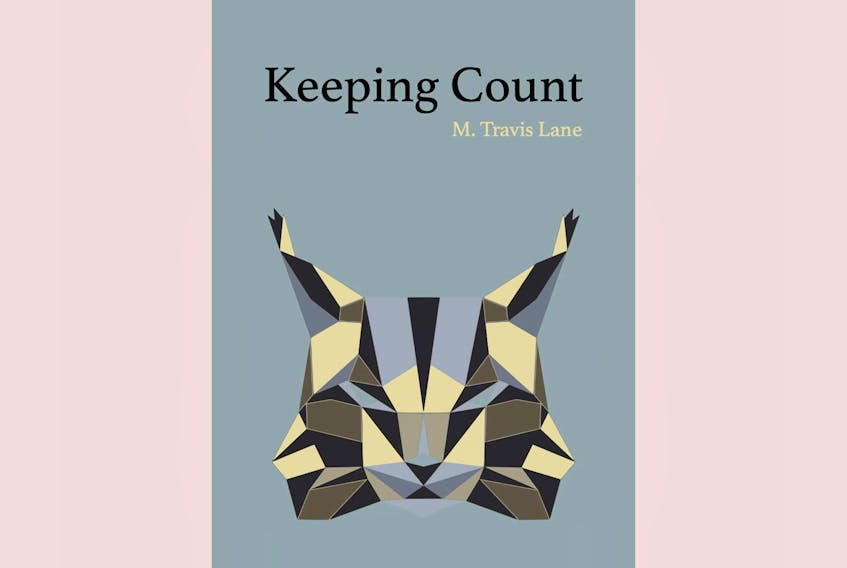“Keeping Count” is M. Travis Lane’s 19th collection of poetry. The award-winning poet (who was also shortlisted for a Governor General’s Award) has published non-fiction as well.
The verses here are divided into three sections, with an introductory poem and an End Note. The opening piece is “The Young Bobcat”: “Now that the world’s so simplified / we have to invent / the wilderness we do not have.” The natural world, its configurations and utterances, are a throughline of concern, encapsulated in the cover depiction of that titular subject in origami portraiture.
“Bobcat” is followed by works grouped into thematic clusters under “Outside,” “Inside,” and “Way Out.”
Among the first texts, in “Murmuration,” “A loose concentric of tiny birds / settles into a demi-lune / veiling a naked tree.” In four brief verses the little flock forms and reforms until “as if a music had shut up, / a poem eased. / They vanished into their vanishing.” “The Satellite” is “like some huge, astral streetlight shines / as if it needed to be seen - / its eastern pose a clown’s pretense, / as steady as it seems at dawn, / a solid astral diamond, / tomorrow it may not be there …”
There is ice, marsh, sky, wind, leaves (“flotsam on the zest / of spring’s unmindful violence”). A “lanky moon keeps swaggering through / the small details of death and birth.” In “The Path To Nowhere,” “The tree that held the world up lost its grasp … // One song, perhaps, reknits it, tangle or nest … // but pull a thread; / music turns into a parking lot …”
This section closes by shifting to a startlingly enclosed space, a cell allotted to “J. H. Latude, prisoner 1725-1805,” and his single, defiant, lonely, two-word message.
Then we wander “inside.”
These works are structured with more direct address, often questions directed at “you”: “Do You Remember?”; “How Can We See What We’re Looking At?”; ”What On Earth Were We Looking For?”
Many are written from the first person point of view, and that viewpoint seems pent, slightly fraught, and restricted.
In “For Ruth,” “Days cluster, days clutter – they open, shut, / heap on the bed like feather quilts. I can nest in them …”
In “Too Quiet” “It gets too quiet / mid-afternoon, midwinter: / no cars, no bus, no students, / and no wind. // What elms? What trains? / My ghosts are broad awake / and seem to follow after me / as if they wanted to be fed – small, feeble, / dusty, shadow-folk.”
Then comes the “Way Out.”
Now age looms, inhabits, and calls the shots.
Titles include “The Fall of Light” and “Walking More Slowly.” In “Stick” “’Bend like water; like water bite.’ / Advice. But what am I? / A stick tossed on the current. I / can’t bend, can’t bite, can’t / mark my way. // I’ve had my green leaves and my bloom. / Now dry, I sense the pull / of oceans I can’t navigate …” The report that “A Star Exploded The Other Day” elicits “(So fragile is our universe, the dew / that diamonds the spider’s net / an option of our galaxy.) // Is it enough to be beautiful?”
The egress of “Way Out” leads in only one human direction. “Outside For An Hour” asks “Will you come today? … // I’ve been reading indoors. Outside / no book, an almost bugless lawn, / the sidewalk to the patio, and an abandoned garden / trough / (‘something to do’ — / a geriatrician’s fantasy.) // The minders have set out plastic rings / to throw in a box. / ‘Show what you’re made of!’ / they shout at their limp clientele. // I ring my help bell, am brought in.”
Lane’s “End Note” delves into “Deep Listening,” a concept she attributes to Janet Thom Hammock.
“I think I have always gone in for ‘deep listening’ but especially now as my hearing decreases. Had I as a child ever heard silence? … I no longer hear bats, some birds. Mumbling, whispering poets have merged for me into the sounds of water on stone or wind on trees.”
What counts, and keeps tick-tock counting? Time. No better moment to take heed, pay attention.
Joan Sullivan is editor of Newfoundland Quarterly magazine. She reviews both fiction and non-fiction for The Telegram.









